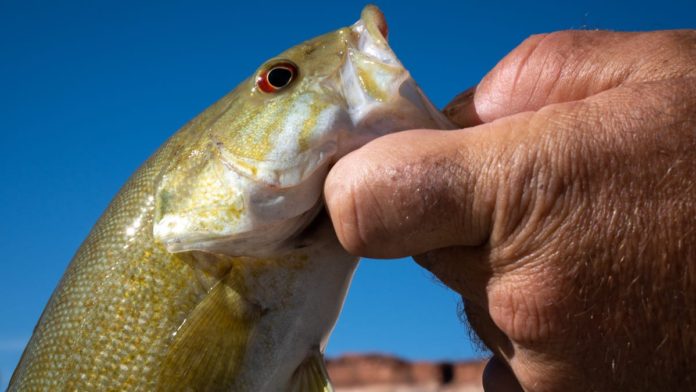LEES FERRY – The National Park Service will poison a Colorado River side channel below Glen Canyon Dam to remove fish that threaten native species, the agency announced.
Meanwhile, biologists warn, rising temperatures and declining oxygen levels in water the dam releases into the river’s Lees Ferry stretch are stressing the popular trout fishery there.
Nonnative smallmouth bass are known to have passed through the dam’s hydropower-generating turbines for several years to reach the Lees Ferry area, but their successful breeding at that stretch was not documented until this year. If it continues, agency officials fear, bass could establish themselves far downstream and eat humpback chubs, which are protected as a threatened species.
“Threats to the native fish are increasing due to the warmer temperatures of water passing through the dam and related increased river temperatures below the dam,” according to a statement released by Glen Canyon National Recreation Area, which includes the river segment. Warmer water apparently aided bass in spawning below the dam, “underscoring the urgency of this emergent issue.”
The Park Service on July 1 found young bass swimming in a slough connected to the river about 3 miles below the dam and 12 miles upstream of where anglers and rafters launch boats at Lees Ferry. It’s the same slough where biologists have in recent years tracked another invader from Lake Powell, the green sunfish. The agency announced it will treat the slough with the fish killer rotenone on Saturday and Sunday. A second treatment may be necessary within two months if more invasive fish are found to have hatched or hidden in the area’s dense vegetation.
While rotenone is a plant-derived chemical commonly used by fish managers, and the Park Service said it will carefully protect the environment and human health by isolating it in the slough, at least one Native American tribe with cultural links to the river and Grand Canyon has objected. The Zuni Pueblo of New Mexico consider the river and canyon sacred. Asked for a response to the fish-kill plan, the Zunis provided The Arizona Republic a Sept. 8 letter that Zuni Gov. Val Panteah Sr. sent to Glen Canyon’s acting superintendent.
‘There’s simply not enough water’: Colorado River cutbacks ripple across Arizona
“The Zuni objection is grounded in our traditional cultural values and the enduring Zuni kinship relationship to all non-human life forms (plants, animals, insects; native and non-native) which have the right to life, liberty, and procreation within their natural environments,” Panteah wrote.
After finding the young bass, the Park Service installed a fabric barrier to keep them from leaving the slough and entering the river. The agency said it will put a water-purifying chemical, potassium permanganate, there and in the river just upstream of the slough to neutralize the rotenone. The slough will be closed during the treatment, but the river – popular with both anglers and kayakers – will remain open.
The stretch of river from the dam to Lees Ferry is a focus in the government’s efforts to protect humpback chubs, which only last year were downlisted on the endangered species list. Beyond bass and other introduced sportfish that swim just above the dam and could push through, brown trout that the Park Service itself stocked for anglers in the river during the 20th century are a potential threat. For that reason, anglers now can claim a bounty for browns that they kill in the river.
But worsening river conditions are now threatening the rainbow trout fishery, which is considered less dangerous to native fish and supports several fly-fishing guide services. The U.S. Bureau of Reclamation, which operates the dam, said this month that the same drought conditions that have plunged Lake Powell’s water levels into crisis are now leaving Lees Ferry water oxygen-starved. Warmer water has less dissolved oxygen, and the reservoir’s sinking surface elevation is causing flows through the dam’s tunnels to warm.
Like many issues tied to the Colorado’s shrinking water supplies, this one is accelerating.
“Reclamation’s water quality forecasts suggested that there was potential for reaching low dissolved oxygen levels below the dam this year, but we didn’t anticipate it happening until early autumn,” Reclamation fish biologist Clarence Fullard said in a statement.
Low oxygen levels can stress and kill trout or force them to move downstream past where riffles add oxygen back into the flowing water. For now, trout remain evident in abundance at Lees Ferry. They attracted Page police officer Chris Seamster last week, where he saw them but couldn’t coax a bite on his lure.
“It might incentivize me to learn how to fly fish,” Seamster said as he left his post near Paria Beach, downstream of the Lees Ferry boat ramp. “A whole lot were jumping. I saw a whole bunch of little ones follow the Rooster Tail in.”
Fishing remains good, though tailwater temperatures that should be around 50 degrees in summer are instead roughly 70, said Wendy Gunn, who owns and operates Lees Ferry Anglers. Midges are keeping the trout fed, even if those trout are stressed.
“The food base is still good,” Gunn said, “so we’re still seeing healthy fish, but we’re starting to see fish struggle and we are seeing some dead fish.”
In the short term, Gunn said, Lake Powell’s seasonal turnover, when cooler layers mix with warmer, should provide some temperature relief in the river by next month. Beyond that, there’s a less reliable remedy: snow. Without a big snowpack in the Rockies, she said, the reservoir’s continued decline could warm the river further next summer, worsening the oxygen depletion.
Brandon Loomis covers environmental and climate issues for The Arizona Republic and azcentral.com. Reach him at brandon.loomis@arizonarepublic.com or follow on Twitter @brandonloomis.
Environmental coverage on azcentral.com and in The Arizona Republic is supported by a grant from the Nina Mason Pulliam Charitable Trust. Follow The Republic environmental reporting team at environment.azcentral.com and @azcenvironment on Facebook, Twitter and Instagram.
Support local journalism. Subscribe to azcentral.com today.
Credit: Source link






























